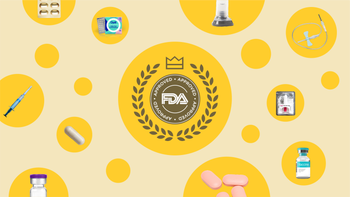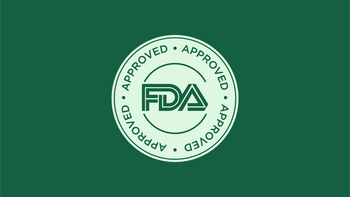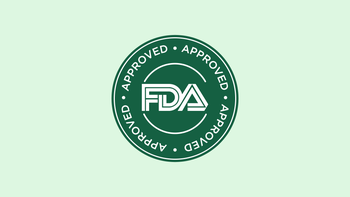
FDA Approval Trends for 2025: Tracking Novel Drugs, First Generics, Biosimilars, and More
Key takeaways:
The FDA approves a range of medications each year, including novel drugs, first generics, biosimilars, and more. Each category plays a unique role in healthcare innovation, cost savings, and access.
During the first half of 2025, novel drug and biosimilar approval have paced slightly behind the numbers from this time in 2024. So far, first generic approval numbers are ahead compared to 2024, which itself lagged behind prior record-setting years.
In late 2024, the FDA finalized a new rule for switching prescription drugs to over the counter (OTC), which went into effect May 27, 2025. This new rule will expand the types of medications that can make the switch, such as statins and erectile dysfunction pills.

Each year, the FDA approves a wide range of medications that help shape the future of medicine in the U.S. These include novel drugs that offer new treatment options, as well as first generics and biosimilars that aim to help lower costs and improve access.
In 2025, tracking these approval trends offers insight into what’s new, what’s going generic, and how the treatment landscape is changing. These patterns may also be influenced by broader factors, such as regulatory reforms, administrative priorities, and the pace of scientific discovery.
Novel drug approvals in 2025
Novel drugs are brand-new medications containing active ingredients that have never been FDA approved before. These therapies often address an unmet medical need or offer meaningful advances over existing treatments. Examples include breakthrough cancer therapies, new antibiotic classes, or first-in-class diabetes medications.
Novel drugs typically go through the New Drug Application (NDA) or Biologics License Application (BLA) process, which involves clinical trials to show they’re safe and effective. Some also receive designations such as priority review, breakthrough therapy, or accelerated approval, which can speed up the FDA review and approval process.
Over the last 10 years, the number of novel drug approvals has varied from year to year:
As of late June 2025, CDER has approved 16 novel drugs this calendar year. This is slightly behind pace compared to this time last year. Recently, the FDA has announced that it plans to use a few different strategies to streamline the drug approval process in certain cases. These include the use of artificial intelligence (AI) and a new Commissioner’s National Priority Voucher program (CNPV). The CNPV program intends to shorten the agency’s review time from 10 to 12 months to 1 to 2 months.
Here is a quarterly comparison of novel drug approvals between 2025 and 2024:
Several high-impact medications, especially in oncology, neurology, and infectious disease, are in the pipeline for potential approval later this year. Here are the 2025 novel drug approvals so far.
Quarter | Medication name | Category |
|---|---|---|
1Q2025 | Datroway (datopotamab deruxtecan-dlnk) | Oncology |
1Q2025 | Grafapex (treosulfan) | Oncology |
1Q2025 | Journavx (suzetrigine) | Pain |
1Q2025 | Gomekli (mirdametinib) | Genetic disorders |
1Q2025 | Romvimza (vimseltinib) | Oncology |
1Q2025 | Blujepa (gepotidacin) | Infectious disease |
1Q2025 | Qfitlia (fitusiran) | Blood disorders |
2Q2025 | Vanrafia (atrasentan) | Kidney disorders |
2Q2025 | Penpulimab-kcqx | Oncology |
2Q2025 | Imaavy (nipocalimab-aahu) | Autoimmune disorders |
2Q2025 | Avmapki Fakzynja Co-Pack (avutometinib and defactinib) | Oncology |
2Q2025 | Emrelis (telisotuzumab vedotin-tllv) | Oncology |
2Q2025 | Tyrptyr (acoltremon) | Ophthalmology |
2Q2025 | Enflonsia (clesrovimab-cfor) | Infectious disease |
2Q2025 | Ibtrozi (taletrectinib) | Oncology |
2Q2025 | Andembry (garadacimab-gxii) | Genetic disorders |
Note: The numbers in this section reflect novel drug approvals by the FDA’s Center for Drug Evaluation and Research (CDER). They do not include approvals for vaccines, cellular or gene therapy products, or other products approved by the FDA’s Center for Biologics Evaluation and Research (CBER).
First generic approvals in 2025
Once a brand-name medication is no longer protected by patents or exclusivity, manufacturers are able to market generic versions of it. The “first generic” is the very first FDA-approved copy of a brand-name medication. A first generic may be eligible for 6 months of exclusivity, meaning that it’ll be the only generic on the market during this time. Other generics can typically enter the scene after this.
First generics (and any subsequent generics) are approved through the Abbreviated New Drug Application (ANDA) process. They don’t typically need to repeat clinical trials for approval. Instead, manufacturers are required to show that the generic is therapeutically equivalent to the brand-name drug. In other words, you can expect the same results.
Over the last 10 years, first generic approvals have also varied:
As of late June 2025, at least 44 first generics have been approved. Keep in mind that first generics may not be available right after approval because of patent protections. They often launch years later.
Examples of 2025 first generic approvals include:
| Quarter | Generic medication |
|---|---|
| 1Q2025 |
|
| 2Q2025 |
|
Note: First generic approval numbers from 2015 through September 2024 are from the FDA’s first generic approval pages. The fourth quarter 2024 numbers are from the FDA’s Generic Drugs Program Monthly and Quarterly Activities report. First generic approvals for 2025 are from the Orange Book Cumulative Supplement. Total 2025 numbers may change as the FDA approves more first generics and updates their reporting for year-to-date approvals.
Biosimilar approvals in 2025
Biologics represent a broad group of complex medications that are made using living systems, rather than chemicals. Biosimilars are highly similar versions of another biologic medication (called the reference product). Like generics with brand-name drugs, biosimilars can potentially help you save money on your biologic prescription.
Biosimilars are approved through the 351(k) BLA pathway, which involves showing that there are no clinically meaningful differences between the biosimilar and the reference product. Some biosimilars may go through additional studies to show that they’re interchangeable with another biologic. This designation can make it easier to switch to a biosimilar at the pharmacy counter (depending on state law).
Biosimilar approvals have fluctuated over the recent years, with 2024 as a record-setting year:
So far in 2025, there have been 8 biosimilar approvals. Here’s how this number compares to 2024 on a quarterly basis:
Here are the 2025 biosimilar approvals so far:
Quarter | Biosimilar name | Reference product |
|---|---|---|
1Q2025 | Avtozma (tocilizumab-anoh) | Actemra (tocilizumab) |
1Q2025 | Osenvelt and Stoboclo (denosumab-bmwo) | Prolia (denosumab) |
1Q2025 | Merilog (insulin aspart-szjj) | Novolog (insulin aspart) |
1Q2025 | Ospomyv and Xbryk (denosumab-dssb) | Prolia and Xgeva |
1Q2025 | Bomyntra and Conexxence (denosumab-bnht) | Xgeva and Prolia |
1Q2025 | Omlyclo (omalizumab-igec) | Xolair (omalizumab) |
2Q2025 | Jobevne (bevacizumab-nwgd) | Avastin (bevacizumab) |
2Q2025 | Starjemza (ustekinumab-hmny) | Stelara (ustekinumab) |
Rx-to-OTC switches
An Rx-to-OTC switch takes place when a prescription medication is approved for over-the-counter (OTC) use, meaning that you can buy it without a prescription. Through this process, the FDA determines that a medication can be safely and effectively used to self-treat symptoms with clear, easy-to-understand labeling.
Rx-to-OTC switches are typically approved through an NDA process. They can be full switches, where the OTC product is marketed for all the same uses as the prescription product. Partial switches, on the other hand, involve only some of the same uses. With either type, the manufacturer needs to show that the product can be safely used without medical supervision.
Rx-to-OTC switches are not as common as other types of approvals. But when these switches are approved, they can have significant public health impacts. Narcan (naloxone), an opioid overdose treatment, and Opill (norgestrel), the first OTC birth control pill, are two recent examples of such approvals.
At the end of 2024, the FDA finalized a new rule that would expand the types of medications that could be eligible for Rx-to-OTC switch, such as statins and erectile dysfunction pills. After a few delays, this rule went into effect on May 27, 2025. The FDA has not approved any Rx-to-OTC switches so far in 2025.
The bottom line
Every year, the FDA approves novel drugs, biosimilars, and first generics. Compared to 2024, novel drug and biosimilar approval numbers are slightly behind in the first half of 2025. First generic approval numbers are pacing ahead. The FDA has not approved any Rx-to-OTC switches so far in 2025.
Why trust our experts?


References
[Please keep the automatic spacing in between references. See Style Guide section on reference formatting.]
Celltrion. (2025). U.S. FDA approves Celltrion's OMLYCLO (omalizumab-igec) as the first and only biosimilar with interchangeability designation referencing XOLAIR. PRNewswire.
Kennedy Jr., R. F. (2025). Nonprescription drug product with an additional condition for nonprescription use. Federal Register.
Petros Pharmaceuticals. (2024). Petros Pharmaceuticals executes successful initial test for app comprehension as part of FDA pathway for over-the-counter access for STENDRA(R) (avanafil). BioSpace.
U.S. Department of Health and Human Services. (2025). Approved drug products with therapeutic equivalence evaluations: 45th edition.
U.S. Food and Drug Administration. (n.d.). Key terms & concepts related to biosimilar and interchangeable products.
U.S. Food and Drug Administration. (2021). Biologics license applications (BLA) process (CBER).
U.S. Food and Drug Administration. (2022). New drug application (NDA).
U.S. Food and Drug Administration. (2024). FDA issues final rule to broaden types of nonprescription drugs available to consumers.
U.S. Food and Drug Administration. (2024). Prescription to nonprescription switch list.
U.S. Food and Drug Administration. (2025). Abbreviated new drug application (ANDA).
U.S. Food and Drug Administration. (2025). Biosimilar product information.
U.S. Food and Drug Administration. (2025). FDA announces completion of first AI-assisted scientific review pilot and aggressive agency-wide AI rollout timeline.
U.S. Food and Drug Administration. (2025). FDA approves first rapid-acting insulin biosimilar product for treatment of diabetes.
U.S. Food and Drug Administration. (2025). FDA roundup: March 4, 2025.
U.S. Food and Drug Administration. (2025). FDA to issue new commissioner’s national priority vouchers to companies supporting U.S. national interests.
U.S. Food and Drug Administration. (2025). Nonprescription drug product with an additional condition for nonprescription use.
U.S. Food and Drug Administration. (2025). Novel drug approvals at FDA.
U.S. Food and Drug Administration. (2025). Novel drug approvals for 2025.
U.S. Food and Drug Administration. (n.d.). Exclusivity and generic drugs: What does it mean?
Was this page helpful?
Related Articles
Browse medications
View AllResearch prescriptions and over-the-counter medications from A to Z, compare drug prices, and start saving.













